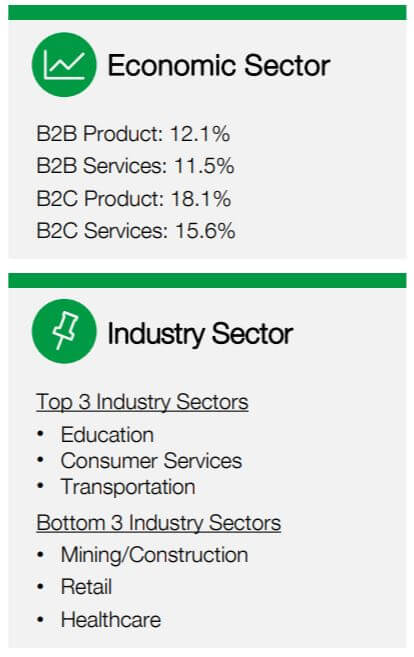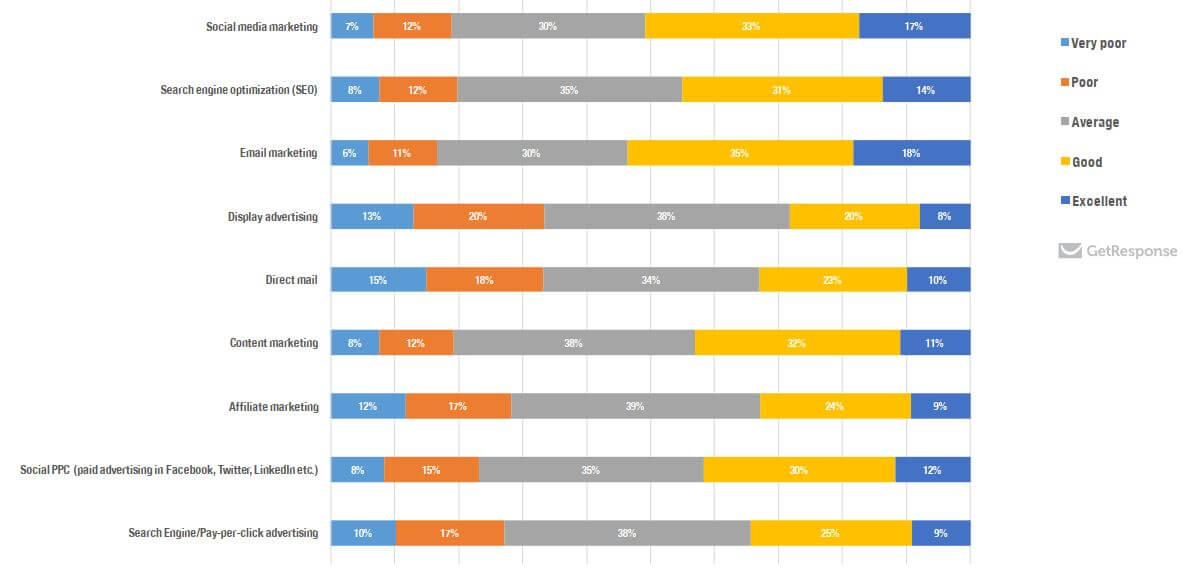
Marketing Budget Allocation Best Practices: The Ultimate Guide for 2021
The process of allocating your marketing budget isn’t inherently complex, but there are several variables that affect the strategy, such as your goals, market, needs, expectations, customer journey, business model, and so on. And it’s these variables that can make knowing how to set a marketing budget such a daunting responsibility.
If WebMechanix had to follow only one marketing budget allocation best practice, it would be this: Put more money into the activities that give you the greatest ROI.
Sounds pretty basic, right? But it’s the minutiae of budget allocation that separate the superstars from everyone else.
Before we dive into whether you get more bang for your buck on Facebook vs. through SEO, let’s take a step back and look at the big picture.
1. Be Aware of Economic Trends and High-Level Business Strategy
Your total marketing budget as a whole is a high-level conversation that may or may not be above your paygrade. However, it’s an important variable to consider since it has a high impact on your company’s success.
Sometimes, you’re correct to submit a proposal for an increased budget because a larger budget will become worth the investment thanks to its positive impact on your business. Other times, such as during a pandemic or economic downturn, the best move is to cut unnecessary costs and reduce waste.
Since 2008, the CMO Survey has been collecting and disseminating feedback from top marketers in America, including how they allocate their marketing budgets.
In June 2020, The CMS Survey produced a Special Edition to assess how marketing activities and spend have been influenced by the upheavals of COVID-19.
Here are some key points you may want to consider as a backdrop to your own marketing budget planning for 2021:
- Marketing budgets, as a percent of overall revenue, have reached an all-time CMO Survey high (11.4%), with 62.3% of marketers saying that marketing has become more important since COVID-19 hit.

- Social media budgets have increased 74% since February 2020, rising from 13.3% of marketing budgets to 23.2%, with marketers mainly using social media for brand building (84.2%) and customer retention (54.3%).
- Unsurprisingly, COVID-19 has accelerated the adoption of digital tools among companies and customers. Of the marketers surveyed, 85% report an increased openness among customers to their digital offerings, and 84% believe that customers currently place more value on digital experiences than they did before the pandemic.
A significant takeaway is that this greater value placed on digital experiences is never expected to revert to pre-pandemic levels, leading to a turning point for many companies in 2021 and beyond. Consider how this might influence your business and marketing budget:
- Will a greater focus on digital experiences affect the touchpoints along your customers’ journey?
- Will you need to increase your home delivery options for physical products in response to demand? (In Italy, e-commerce sales rose by 81% in a single week.)
- Does the digital experience align with your existing business model, brand values, and promises?
- New adopters of e-commerce and digital brands (mainly people aged over 45) have increased significantly around the world. Does this trend open new opportunities for you to increase sales beyond a core millennial customer base?
- How much do you need to pivot your marketing budget in response to this rapid change in customer behaviors, profiles, and needs?
2. Use Conversion Optimization
What does ROI look like in your organization? That may sound like a dumb question—ROI is a relatively straightforward calculation, based on the cost to acquire a sale. But let’s look at the three basic steps taken to arrive at that sale:
- Awareness: First, you have to make the customer aware of your brand by building trust and interest.
- Consideration: As the interest builds into active consideration, you need to entice those people to visit your website, landing pages, or sales floor before you can turn them into an active lead.
- Conversion: Finally, you have to qualify and convert the lead into a sale through hard conversion techniques such as pricing, special offers, scarcity, sales presentations, demonstrations, and so on.
The steps are seldom that structured, but it’s highly unlikely that you’ll convert a complete stranger into a customer without going through all stages of the sales funnel. So, let’s start with the premise that each stage is equally important. Does this mean you should allocate your marketing budget equally across all three stages? Possibly—but maybe not. Maybe you should focus a little more attention on your conversion optimization activities. Here’s how and why.
Take a look at your previous marketing budget and break down the core activities and costs into three buckets. In the Awareness bucket, you might include your social media campaigns and organic content, brand advertising, PR activities, and so on. Anything that drives traffic to your physical shop front or online presence would go into Consideration, while everything else goes into the Conversion bucket.
Now, how much did you spend in each bucket? Make a note of your conversion rate and ROI. Let’s say your results look something like this—a typical marketing budget example with an emphasis on building the brand and driving traffic:
| Budget (12 months) | 2020 |
| Awareness: | $400k |
| Consideration: | $400k |
| Conversion: | $200k |
| Total Budget: | $1m |
| Conversion Rate (%) | |
| #Active Leads: | 100k |
| #Sales | 8k |
| Conversion Rate | 8% |
| ROI (%) | |
| Revenue from total sales: | $4m |
| Average revenue per sale: | $500 |
| ROI* | 300% |
*ROI calculated as: (Total Revenue – Marketing Budget) / Marketing Budget x 100
Those are pretty good results, and you may decide not to adjust your budget allocations across the three buckets for the next 12 months.
But spend some time looking at your individual metrics and KPIs. Are there some areas that could use a boost? Did you achieve the traffic and leads you wanted but with a lower conversion rate than you expected?
What if you were to put a greater focus on your conversion activities and shift dollars away from the other buckets? On the downside, you might lose traffic and active leads. But this budget shift could increase your conversion rate, with a ripple effect of increasing your ROI by 33%:
| Budget (12 months) | 2020 | 2021 | ||
| Awareness: | $400k | $300k | ||
| Consideration: | $400k | $350k | ||
| Conversion: | $200k | $350k | ||
| Total Budget: | $1m | $1m | ||
| Conversion Rate (%) | ||||
| #Active Leads: | 100k | $80k | Leads down by 20% | |
| #Sales | 8k | 10k | ||
| Conversion Rate | 8% | 12.5% | Rate up by 4.5% | |
| ROI (%) | ||||
| Revenue from total sales: | $4m | $5m | ||
| Average revenue per sale: | $500 | $500 | ||
| ROI* | 300% | 400% | ROI up by 33% |
We’re not advocating that conversion optimization should suddenly become your number-one budget priority. You need to do a critical analysis of your data and metrics and allocate your budget accordingly so that each bucket of activity is pulling its weight and supporting the others. But never lose sight of how an improved conversion rate could improve your bottom line.
3. Know Your Customer’s Journey
This is where the subtleties of marketing can get a little thorny. We’ve just talked about the importance of conversion optimization within the linear concept of a sales funnel. But life isn’t linear, and every customer’s journey isn’t a neat slide through a sales funnel. It’s an intricate relationship that can last for days, weeks or even years, with many iterations.
So, while a typical marketing ROI is based on the leads-to-sales conversion rate, this can be misleading because active leads are only one segment of your customer base. Therefore, the principles of conversion optimization need to start right back at the awareness stage and reappear at touch points throughout the customer’s journey. In other words, your marketing budget needs to include conversion optimization and customer journey optimization. Here are some of the budgetary considerations:
- Customer Journey Mapping: Without a customer journey map, allocating your budget will be largely guesswork. Every business—particularly post-COVID-19— needs a customer journey map. Here’s a good overview of how to create one from the Digital Marketing Institute.
- Continual Improvement: Mapping your customers’ journey is not a set-it-and-forget-it exercise. It needs to be a collaborative and ongoing team effort to understand customers better. You may need to allocate resources to make sure this happens.
- Data and Analytics: To continually improve, you need access to the appropriate data and the analytical skills to manage and interpret the data. Many larger organizations have this skill and technology in house. If not, you need to include a budget allocation to outsource it.
- CRM Software: Does your organization have the technical capacity to effectively manage existing customers through their journeys and to automate cross-selling, upselling, and retention strategies? If not, do you need to spend more money to upgrade these capacities?
4. Align Your Marketing Budget Breakdown with Goals and KPIs
Marketing Goals
Budgeting is less complicated when you approach it with intention and goals. Typically, your main intention will be to achieve a revenue goal and meet the KPIs against which your boss measures you. But how you meet those goals and KPIs will vary.
If, for example, you’re launching a new consumer e-commerce business, your goals are going to be focused on building your brand and driving high-volume traffic to your online store. You’ll be looking for maximum clicks and impressions, with an emphasis on social media, PPC advertising, and retargeting campaigns. Your focus will be on a predominantly digital marketing budget allocation.
But if you’re an established B2B organization that’s obtaining lots of leads with a sales team that can’t manage all the leads, your marketing priorities are likely to be concentrated on expanding your sales team.
Business Goals
You should never plan your marketing budget without understanding its role in in the context of your organization and the overall goals and KPIs you are expected to achieve.
Marketing plans tend to be designed for a period of 12 months, with monthly and annual reviews, and marketing budgets are allocated accordingly. But organizational plans can include new, long-term growth strategies that take more time to mature, like new product development or expansion into new geographical areas or new social media platforms.
In these situations, your marketing budget may need to include new customer research, product testing, sales team training, and other initiatives that may not directly contribute to revenue goals in the short-term. Which emerging areas you should invest in depends on the problems that you care most about solving and the marketing areas you’d like to explore.
If you feel you need to know more about your customer since it will pay off later, invest in customer research methods. If you find that your best (or new) target audience segments are coming from SEO, invest in SEO. If you’re interested in new channels that might help pre-qualifying and nurturing prospects better than before, maybe invest in email marketing, display advertising, or trade shows.
Once you’ve decided on where you want to allocate your budget, you need to decide how you’ll divy it up among those areas. That plan will reflect the intentions of your marketing strategy as well as organizational KPIs, prioritized by you and upper management.
5. Use Industry Benchmarks and Trends as a Guide
Established benchmarks, such as marketing budgets by industry, are useful guidelines when planning your budget allocation. For example, here are some benchmarks and trends from February 2020, (prior to the abnormal rises and falls caused by COVID-19, many of which are expected to re-adjust to pre-pandemic levels sometime in 2021):
- Customers are expected to place a stronger emphasis on trusting relationships (40.2% increase).
- Spending on the customer experience has increased 71% over the last three years, and marketers expect to spend 36% more over the next three years.
- Internet sales as a percent of revenues have risen to 13.5%, the highest level in a decade. B2C services companies are dominant in this space at 18.1%.
- Spending on social media grew to 13% of marketing budgets, reaching the second-highest point in CMO Survey history in February 2020.
- Companies continue to prioritize organic growth, regardless of size, level of internet sales, or sector.
- Spending on existing markets and offerings continues to dominate growth spending.
- Growth in digital marketing greatly outpaces growth in traditional marketing, with consistent, strong growth in digital marketing and relatively steady traditional advertising spending.
- Marketing capability development continues to be the top critical knowledge investment for companies, with service companies prioritizing this investment more than product companies. Meanwhile, training and development spend as a percent of marketing budgets remains the focus of B2B marketers.
Percentage of company sales through the internet by sector:

Marketing budget as a percentage of company revenues by sector:

Growth in digital marketing by sector:

While we don’t believe in using industry benchmarks and trends as a marketing budget allocation model, they can provide valuable insights when aligned with your own metrics and historical data. This leads us nicely into the more granular aspects of planning your marketing budget…
6. Get Granular on What’s Working
In a survey of 2,500 digital marketers, respondents were asked which budget allocations they planned to increase, decrease, or keep the same across various marketing channels. While the survey was conducted in 2017, the results on digital spending have continued to show similar trends:
- Email marketing was given the highest priority, with 58% of marketers stating they planned to increase their budget allocation in this area. Email marketing also received the largest budget allocation of all channels.
- Social media advertising (PPC) received the second-largest budget allocation, with 50% of marketers planning to increase spending in 2017.
- These were closely followed by content marketing, SEO, search engine PPC.

Source: Get Response Global Industry Benchmarks 2017
Unsurprisingly, the results were similar when the same marketers were asked which channels delivered the highest ROI. The top channels resulting in good to excellent ROI were:
- Email (53%)
- Social media (50%)
- SEO (45%)
- Content marketing (43%)
- Social PPC (42%)

Source: Get Response Global Industry Benchmarks 2017
We can’t give you a one-size-fits-all answer to how or where to allocate your marketing dollars—every company is going to have different needs. But these results are a clear indication of the strategies and tactics that are growing in importance and effectiveness in digital marketing, so they make a good starting point.
However, as always, you need to assess each channel through the lens of your own goals, customer journeys (where are they hanging out?), and historical performance. It’s all about figuring out which initiative will be most impactful. Here are some things to consider:
- PPC is one of the fastest growing channels on social media and search engines. They both require a sophisticated level of understanding and a steep learning curve if you intend to master them yourself. You may have an in-house team of experts, but if you don’t, we recommend you include the cost of outsourcing this skill in your budget. More specifically, for Google Ads, your PPC manager should be asking which keywords are converting the best. That will help you get granular to figure out which keywords should receive your reallocated spend.
- Pick the right social media channel for your organization. Start there and scale later. Spread yourself too thin in the beginning. Facebook, LinkedIn, and Instagram are the current giants, but which initiative or campaign has the highest priority for you in 2021? Do you want to build your brand awareness, drive traffic to your website, or grow your email list? Which channel and tactic is going to best help you achieve that? If PPC advertising on Facebook has been working well for you, then budget to scale up, but leave some room to trial-run other platforms. To get granular here, identify the best audiences to target on Facebook. WebMechanix has found that retargeting audiences usually work well. Keep segmenting and trying new audiences, such as lookalike audiences.
- A word of caution while you’re scaling up: Beware of diminishing returns. The mindset of spend more to get more works up to a point and is a fallacy when it comes to PPC. Every PPC campaign has a non-linear curve on spend vs. return (see the chart below). There are always diminishing returns on conversions, and at some point on the curve, the more you spend, the more you waste. So, be prepared to look for new methods of reaching your prospects, or you’ll hit a plateau where you’ve exhausted all viable prospects on the platform.

- If you want to focus on strategies that provide valuable relationship-building and lead-generation capabilities, then consider content marketing in your budget allocations. It’s more of a slow burner than PPC advertising, but it provides touchpoints at different stages of a customer’s journey and plenty of SEO opportunities. Don’t just budget for content creation. Publishing and promoting your content across your social media channels can be equally important.
Simply put, you can get very granular with how you allocate budget inside an advertising platform. This means that part of your budget allocation process sometimes gets passed down to your strategist as they work in a platform to find the best placements, images, and audiences. That person should invest in more of what’s working but also leave a little room for new initiatives.
7. Calculate Your Marketing Acquisition Costs
We discussed ROI at a macro level earlier. But it’s just as important to examine your costs and business metrics at a micro level too, such as cost per click (CPC) and cost per lead (CPL). These should also be broken down again as CPC and CPL per marketing channel.
(Note: If you don’t have the time or expertise to access to this type of detailed data, you may want to consider paying for an expert or agency to determine your future costs and conversion rates.)
Armed with this information, your budget planning becomes razor focused.
Let’s say one of your goals is to achieve 2,000 additional sales in 2021. You know your conversion rate is 12%, so that means you’re going to need roughly 16,000 more active leads in that year. Your average CPL is $10, so you’re either going to have to pump an additional $160k into your budget or allocate more to right lead generation techniques and conversion tactics and less to what’s not working.
8. Plan for the Unexpected
Every marketing budget needs a contingency. As a rule of thumb, aim to set aside 5–10% of your overall marketing budget. You should always have access to these funds, as it’s impossible to anticipate when things will go wrong (and they will eventually).
New opportunities will arise that you couldn’t have foreseen. TikTok, for example, exploded onto the market in 2016 and now has 800 million active users worldwide. A contingency plan in your budget gives you the opportunity to jump on new trends before your competition does. Contingencies allow you to remain flexible, pivot quickly, and monitor the future in case you need that budget for emergencies.
9. Beware of Hidden Costs
You may think you’ve captured everything you need in your marketing budget, but take a closer look at some of those line items:
- Are you launching a new product in 2021? Have you included the advertising testing and fees in your budget? Do you know if your campaigns are going to hit the mark when you roll them out?
- Are you planning on hiring new employees? Have you budgeted for their on-boarding costs, admin, insurance, recruiting, additional software and technology, benefits, and other hidden employment costs?
- Don’t overlook opportunity costs either. If you intend to send staff to conferences, or pay for training courses, what sales opportunities will be lost while their focus is diverted?
10. Monitor and Review to Find the Best Bang for your Buck
We’ve saved the best tip for last. As we’ve already alluded, you’ll need to monitor and review what’s working best frequently to optimize your strategy, reduce wastage, and reallocate your funds accordingly.
You should put more money into what’s working and less into what’s not. But more money in what?, you ask. Fair enough—let’s get more specific.
Here are some specific areas where you may be able to budget more based on performance:
- Which keywords are converting best in your paid search and content marketing?
- Which audience segment is responding better to your social media ads? If one stands out, try creating a lookalike audience to see if that boosts leads or if you can optimize that segment even more.
- Which ads are working best? Have you tried A/B testing your images and headlines?
- Which ad placements and formats are working best?
- Which initiative or campaign is generating the most sales or leads?
Also, remember to continue monitoring your performance at least once a week. You should:
- Access and analyze your metrics and data to assess what’s working and what’s not.
- Measure your ROI across all marketing channels and metrics.
- Keep your goals and priorities front and center.
- If something is not adding value or helping to achieve a goal, refine or eliminate it altogether.
- Always assess your budget allocation versus actual spend. Where did you go over or under, and how can you compensate for this next month?
Not only will this help keep your budget on track in 2021, but the results of your monthly reviews will also make future budget planning a breeze.
A Final Word on Marketing Budget Allocation Best Practices
In hindsight, 2020 has been one of the most challenging (and possibly defining) years for marketers. Depending on the industry you’re in, your budget may have been slashed or increased, and you’ve likely had fewer resources to work with.
The old approach of tweaking last year’s marketing budget is no longer relevant. Organizations of all sizes and from all sectors need to adopt a more granular and analytical attitude for planning that relies on data and results, not guesswork.
Follow the best practices we’ve outlined here, and your marketing budget process will be far more strategic and effective.
Most newsletters suck...
So while we technically have to call this a daily newsletter so people know what it is, it's anything but.
You won't find any 'industry standards' or 'guru best practices' here - only the real stuff that actually moves the needle.






